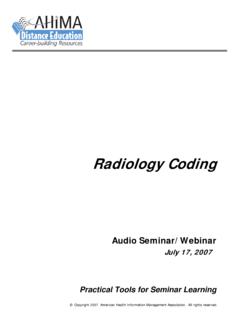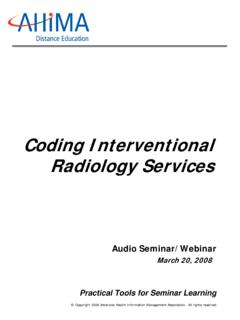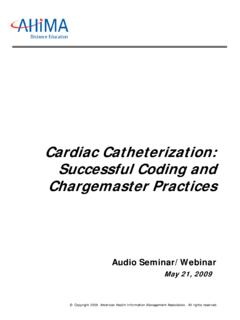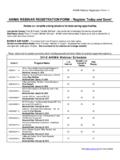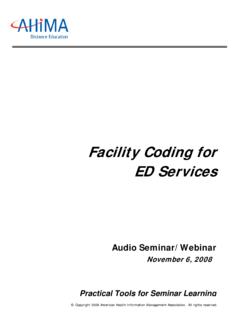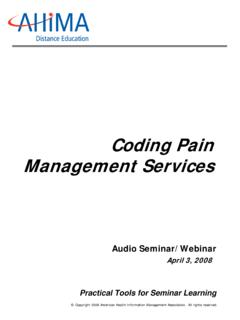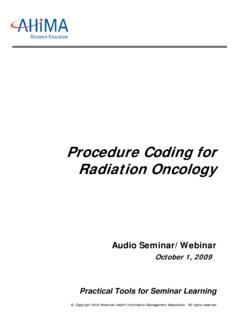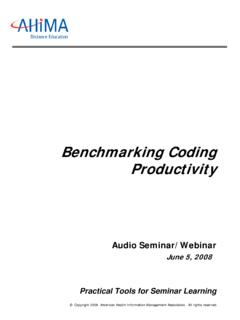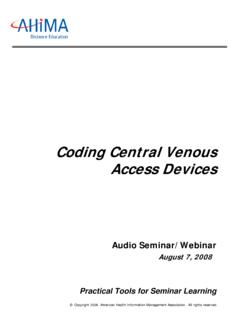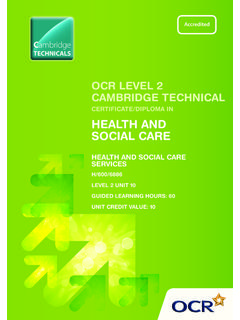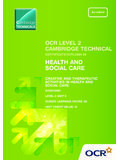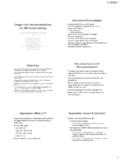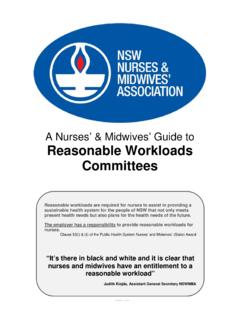Transcription of Physician Practice E/M Guidelines
1 Copyright 2009 American Health Information Management Association. All rights reserved. Physician Practice E/M Guidelines Audio Seminar/Webinar November 10, 2009 Practical Tools for Seminar Learning Disclaimer AHIMA 2009 Audio Seminar Series American Health Information Management Association 233 N. Michigan Ave., 21st Floor, Chicago, Illinois i The American Health Information Management Association (AHIMA) makes no representation or guarantee with respect to the contents herein and specifically disclaims any implied guarantee of suitability for any specific purpose. AHIMA has no liability or responsibility to any person or entity with respect to any loss or damage caused by the use of this audio seminar, including but not limited to any loss of revenue, interruption of service, loss of business, or indirect damages resulting from the use of this program.
2 AHIMA makes no guarantee that the use of this program will prevent differences of opinion or disputes with Medicare or other third party payers as to the amount that will be paid to providers of service. CPT five digit codes, nomenclature, and other data are copyright 2009 American Medical Association (AMA). All Rights Reserved. No fee schedules, basic units, relative values or related listings are included in CPT . The AMA assumes no liability for the data contained herein. As a provider of continuing education the American Health Information Management Association (AHIMA) must assure balance, independence, objectivity and scientific rigor in all of its endeavors. AHIMA is solely responsible for control of program objectives and content and the selection of presenters. All speakers and planning committee members are expected to disclose to the audience: (1) any significant financial interest or other relationships with the manufacturer(s) or provider(s) of any commercial product(s) or services(s) discussed in an educational presentation; (2) any significant financial interest or other relationship with any companies providing commercial support for the activity; and (3) if the presentation will include discussion of investigational or unlabeled uses of a product.
3 The intent of this requirement is not to prevent a speaker with commercial affiliations from presenting, but rather to provide the participants with information from which they may make their own judgments. The faculty has reported no vested interests or disclosures regarding this presentation. Usage Rights This document is exclusively for use by individuals attending the associated audio seminar or webinar (named on the first page of this document), in conjunction with their attendance of the live or recorded version of the presentation. All material herein is copyright 2009 American Health Information Management Association (AHIMA), except where otherwise noted. It may not be redistributed without prior written permission from AHIMA. Faculty AHIMA 2009 Audio Seminar Series iiCarolyn M.
4 Roberts, CCS, CCS-P, CPC, CPC-I Carolyn Roberts is senior compliance, audits and education specialist for Baystate Medical practices in Springfield, MA. Ms. Roberts has extensive coding and auditing experience in the Physician Practice setting with steadily increasing roles as a coder, chart auditor, coding instructor, and Physician educator. She has been a co-facilitator for the Coding for Physician Practice community since its inception in 2004. Lance J. Smith, RHIT, CCS-P Lance Smith is coding analyst for Montefiore Medical Center in Bronx, NY. Previously, Mr. Smith held various positions including billing supervisor, coding supervisor, coder and Physician educator, and assistant director of HIM. He is also a current member of the AHIMA Physician Practice Council, and the NYHIMA ICD-10-Work Group.
5 Table of Contents AHIMA 2009 Audio Seminar Series Disclaimer .. i Faculty .. ii Presentation Objectives .. 1 General Documentation Principles .. 1-2 Medical Necessity .. 2-3 Volume of Documentation .. 3 Varying E/M Documentation Guidelines .. 4 Evaluation and Management Overview .. 4 E/M Services Contain 7 Components .. 5 Key Components .. 5-6 History Element .. 6 History of Present Illness .. 7-8 Review of Systems .. 8 Past, Family and Social History .. 9 Examination 1995 vs. 1997 .. 9 1995 Body Areas (BA) for Exam .. 10 1995 Organ Systems for Exam .. 10-11 Four Levels of Examination (1995) .. 11 What's the Difference Between an EPF and a Detailed Exam (1997) .. 12 11 Single System Examinations (1997) .. 13 Multisystem Examination (1997) .. 14 Single System Examination (1997).
6 14 Examination 1995 vs. 1997? .. 15 Example: Established Patient Office Visit .. 15-16 Exaample: Initial Psych Inpatient Exam .. 16-17 Medical Decision Making .. 18-22 Diagnoses or Management .. 18-19 Amount of Data .. 20-21 Risk .. 21 Table of Risk Guide .. 22 Table of Risk .. 22 Putting It All Together .. 23 Example: Established Patient Office Visit .. 24-25 Review of Systems & PFSH .. 25 Determine the Level of History .. 26 Determine Level of Exam .. 26 Determine Level of MDM Points for Diagnoses/Management Options & Data .. 27 Determine Level of Risk .. 27 MDM Table of Risk Guide Choose Highest Level in Any Box .. 28 Determine Level of MDM.
7 28 Now Determine the Established Patient Visit Level Requires 2 Key Components .. 29 (CONTINUED) Table of Contents AHIMA 2009 Audio Seminar Series Time Factors .. 29 Visits Dominated by Counseling .. 30 Selecting Visit Level by Time .. 30-31 Documenting Time .. 31 Example Time .. 32 Consultations .. 33 Resource/Reference List .. 34 Audio Seminar Discussion .. 35 Become an AHIMA Member Today! .. 35 Audio Seminar Information Online .. 36 Upcoming Audio Seminars .. 36 Thank You/Evaluation Form and CE Certificate (Web Address) .. 37 Appendix .. 38 Resource/Reference List .. 39 CE Certificate Instructions Physician Practice E/M Guidelines AHIMA 2009 Audio Seminar Series 1 Notes/Comments/QuestionsPresentation Objectives Discuss and compare 1995 and 1997 Guidelines Summarize documentation requirements Explain how to determine which documentation Guidelines are more advantageous to the Physician Time-based E/M coding Medical necessity1 General Documentation Principles The medical record should be complete and legible Documentation of each patient encounter should include.
8 Reason for the encounter and relevant history, physical examination findings and prior diagnostic test results assessment, clinical impression or diagnosis plan for care date and legible identity of the observer2 Physician Practice E/M Guidelines AHIMA 2009 Audio Seminar Series 2 Notes/Comments/QuestionsGeneral Documentation Principles Reason for ordering tests and ancillary services should be documented or easily inferred Past and present diagnoses should be accessible Health risk factors should be identified The patient's progress, response to and changes in treatment, and revision of diagnoses should be documented The CPT and ICD-9-CM codes reported should be supported by the documentation3 Medical Necessity Medical necessity is the overarching criterion for payment in addition to the individual requirements of a CPT code (CMS Manual, Publication 100-4, Chapter 12, Section ) The chief complaint, reason for the visit or presenting problem establishes medical necessity and the reasonableness of the service Caveat: EHR and other templates make it easy to document comprehensive levels of history and exam Is it necessary?
9 4 Physician Practice E/M Guidelines AHIMA 2009 Audio Seminar Series 3 Notes/Comments/QuestionsMedical Necessity Example A young otherwise healthy established patient presents to the office with sprained ankle Physician performs a comprehensive history and a head-to-toe exam Should a 99215 be coded? Was a comprehensive history and exam necessary?5 Volume of Documentation The volume of documentation is not the sole indication for a level of service Documentation that meets Guidelines for a given level of service (LOS) but is excessive for the treatment of the patient may not be considered when assigning a visit level Assign E/M level based upon the relevant history, exam and medical decision making 6 Physician Practice E/M Guidelines AHIMA 2009 Audio Seminar Series 4 Notes/Comments/QuestionsVarying E/M Documentation Guidelines Follow documentation Guidelines , scoring, etc.
10 For your local carrier/Medicare Administrative Contractor (MAC) Check third party payer websites and manuals for variations In absence of written requirements to the contrary, most will accept Medicare s because they are considered the gold standard 7 Evaluation and Management Overview 3-5 levels of service within each E/M category or subcategory New vs. established patient Initial vs. subsequent Place of service (POS) dependent Requirements not interchangeable between categories Consider patient type, POS and E/M category before assigning E/M code8 Physician Practice E/M Guidelines AHIMA 2009 Audio Seminar Series 5 Notes/Comments/QuestionsE/M Services Contain 7 Components History Physical Exam Medical Decision Making_____ Counseling Coordination of Care Nature of the Presenting Problem Establishes medical necessity Time Controlling factor only when visit dominated by counseling and/or care coordination9 Key Components All 3 key components need to be met or exceeded for.

